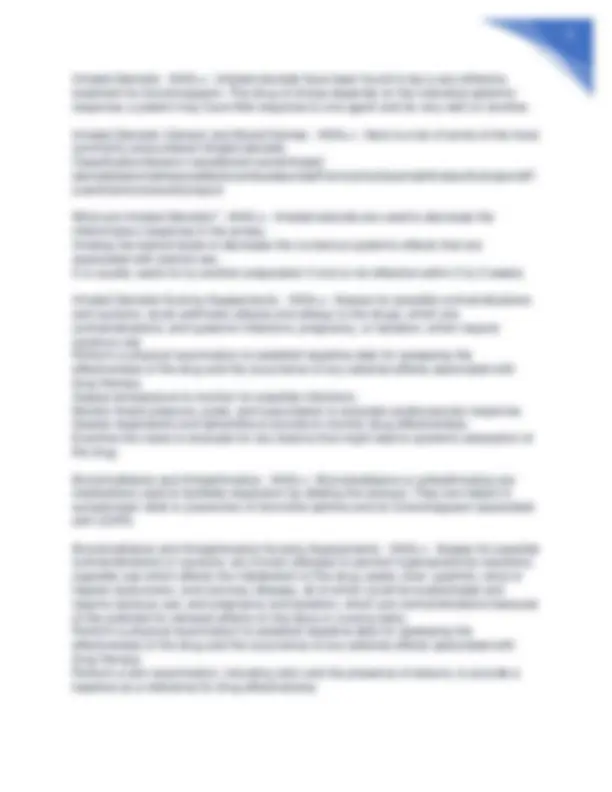






Study with the several resources on Docsity

Earn points by helping other students or get them with a premium plan


Prepare for your exams
Study with the several resources on Docsity

Earn points to download
Earn points by helping other students or get them with a premium plan
Community
Ask the community for help and clear up your study doubts
Discover the best universities in your country according to Docsity users
Free resources
Download our free guides on studying techniques, anxiety management strategies, and thesis advice from Docsity tutors
Information on various types of drugs, including antacids, inhaled steroids, bronchodilators, thyroid agents, insulin, adrenergic agonists, anticholinergics, immunosuppressants, anti-inflammatory agents, nonsteroidal anti-inflammatory drugs (nsaids), antiviral drugs, antibiotics, anesthetics, psychotherapeutic agents, anticoagulant drugs, antiplatelet drugs, thrombolytic agents, diuretics, and antihypertensive drugs. It discusses their actions, contraindications, cautions, and nursing assessments.
Typology: Exams
1 / 8

This page cannot be seen from the preview
Don't miss anything!





Antacids - ANS>> Antacids are used to chemically react with and neutralize the acid in the stomach. They can provide rapid relief from increased acid levels. They are known to cause GI alterations such as diarrhea or constipation and can alter the absorption of many drugs. Antacids: Generic and Brand Names - ANS>> Here is a list of the most commonly encountered antacids and their brand names. ClassificationGeneric nameBrand nameAntacidsaluminum saltsAlternaGELcalcium saltsOystercal, TumsmagaldrateLosopan, Riopanmagnesium saltsMilk of Magnesia, otherssodium bicarbonateBell-ans What are antacids? - ANS>> Antacids are a group of inorganic chemicals that neutralize stomach acid. Antacids are available OTC, and many patients use them to self-treat a variety of GI symptoms. The choice of an antacid depends on adverse effects and absorption factors. Antacids Therapeutic actions - ANS>> The desired actions of antacids include the following: Neutralize stomach acid by direct chemical reaction. Symptomatic relief of an upset stomach associated with hyperacidity, as well as the hyperacidity associated with peptic ulcer, gastritis, peptic esophagitis, gastric hyperacidity, and hiatal hernia. Antacids Contraindications and Cautions - ANS>> The following are contraindications and cautions when using antacids: Allergy. The antacids are contraindicated in the presence of any known allergy to antacid products or any component of the drug to prevent hypersensitivity reactions. Co-morbidities. Caution should be used in the following instances: any condition that can be exacerbated by electrolyte or acid-based imbalance to prevent exacerbations and serious adverse effects; any electrolyte imbalance , which could be exacerbated by the electrolyte-changing effects of these drugs; GI obstruction which could cause systemic absorption of the drugs and increase adverse effects; renal dysfunction, which could lead to electrolyte disturbance if any absorbed antacid is neutralized properly. Pregnancy and lactation. Antacids are contraindicated for pregnant and lactating women because of the potential for adverse effects on the fetus or neonate. Histamine-2 (H2) receptor antagonists - ANS>> Histamine-2 (H2) receptor antagonists block the release of acid in response to gastrin or parasympathetic release.
Histamine-2 Antagonist: Generic and Brand Names - ANS>> Here is a table of the most commonly used H2 antagonists. ClassificationGeneric nameBrand nameHistamine- 2 antagonistscimetidineTagametranitidineZantacfamotidinePepcidnizatidineAxid H2 blockers Therapeutic actions - ANS>> The desired actions of H2 antagonists include the following: Selectively block H2 receptors located on the parietal cells. Prevents the release of gastrin, a hormone that causes local release of histamine (due to stimulation of histamine receptors), ultimately blocking the production of hydrochloric acid. Decreases pepsin production by the chief cells. Proton Pump Inhibitors - ANS>> The gastric acid pump or proton pump inhibitors suppress gastric acid secretion by specifically inhibiting the hydrogen-potassium adenosine triphosphate enzyme system on the secretory surface of the gastric parietal cells. Proton Pump Inhibitors: Generic and Brand Names - ANS>> Here is a table of the most commonly encountered proton pump inhibitor: ClassificationGeneric nameBrand nameProton pump inhibitorsdexlansoprazoleKapidexesomeprazoleNexiumlansoprazolePrevacidomeprazol ePrilosecpantoprazoleProtonixrabeprazoleAciphex What are Proton Pump Inhibitors? - ANS>> Proton pump inhibitors suppress the secretion of hydrochloric acid into the lumen of the stomach. PPI Nursing Assessment - ANS>> Assess for possible contraindications and cautions: history of allergy to a proton pump inhibitor to reduce the risk of hypersensitivity reaction and current status of pregnancy or lactation because of the potential for adverse effects on the fetus or nursing baby. Perform a physical examination to establish baseline data before beginning therapy to determine the effectiveness of the therapy and to evaluate for the occurrence of any adverse effects associated with drug therapy. Inspect the skin for lesions, rash, pruritus, and dryness to identify possible adverse effects. Assess neurological status, including level of orientation, affect and reflexes to evaluate for CNS effects of the drug. Inspect and palpate the abdomen to determine potential underlying medical conditions; assess for changes in bowel elimination and GI upset to identify possible adverse effects. Assess respiratory status, including respiratory rate and rhythm; note evidence of cough, hoarseness, and epistaxis, to monitor for potential adverse effects of the drugs.
Monitor blood pressure, pulse, cardiac auscultation, peripheral perfusion, and baseline electrocardiogram to provide a baseline for effects on the cardiovascular system. Assess bowel sounds and do a liver evaluation and monitor liver and renal function tests to provide a baseline for renal and hepatic function tests. Evaluate serum theophylline levels to provide a baseline reference and identify conditions that may require caution in the use of xanthines. Evaluate urinary output and prostate palpation as appropriate to monitor anticholinergic effects. Evaluate orientation, affect, and reflexes to evaluate CNS effects. Thyroid Agents - ANS>> Thyroid gland is located in the middle of the neck and surrounds the trachea like a shield. It produces two hormones: thyroid hormone and calcitonin. The thyroid gland uses iodine to produce thyroid hormones that regulate body metabolism. Thyroid agents either replace or remove hormones to prevent deficiency and excess. Thyroid agents include thyroid hormones (T3, T4, TSH)and antithyroid drugs (further classified as thioamides and iodine solution). Insulin - ANS>> Insulin is a drug that is used to control glucose in patients with diabetes mellitus. It is the only parenteral antidiabetic agent available for exogenous replacement of low levels of insulin. Insulin is the hormone produced by the pancreatic beta cells of the islets of Langerhans. It is released into circulation when the levels of glucose around the cells arise. Insulin circulates through the body and reacts with specific insulin receptor sites to stimulate the transport of glucose into cells to be used for energy (facilitated diffusion). Originally prepared from pork and beef pancreas, virtually all insulin is prepared by recombinant DNA technology now. This is a purer form of insulin and is not associated with sensitivity problems that many patients developed with the animal products. Sulfonylureas - ANS>> Sulfonylureas are another group of agent used to control blood glucose level. These drugs are only effective in patients who have functioning beta cells. They are not effective for all diabetics and may lose their effectiveness over time with others. Sulfonylureas are further classified as first-generation or second-generation sulfonylureas. Use of first-generation sulfonylureas is declining as more effective drugs have become available. Also, they are now thought to possibly cause an increase in cardiovascular death. Use of second-generation sulfonylureas have several advantages over first-generation, including: safer for patients with renal dysfunction as they are excreted in urine and bile, absence of interaction to many protein-bound drugs, and longer duration of action. All of sulfonylureas can cause hypoglycemia. Adrenergic Agonists (Sympathomimetics) - ANS>> The autonomic nervous system (ANS) works to keep the body's homeostasis against internal and external changes in the environment which alter the body's internal functions (e.g., blood pressure regulation, urinary excretion, water balance, and digestive functions).
Adrenergic agonists are autonomic nervous system drugs that stimulate the adrenergic receptors of the sympathetic nervous system (SNS), either directly (by reacting with receptor sites) or indirectly (by increasing norepinephrine levels). An adrenergic agonist is also called a sympathomimetic because it stimulates the effects of SNS. Adrenergic agonists are further classified into three: alpha- and beta-adrenergic agonists, alpha-specific adrenergic agonists, and beta-specific adrenergic agonists. Anticholinergics (Parasympatholytics) - ANS>> Anticholinergics are drugs that oppose the effects of acetylcholine. In essence, they also lyse and block the effects of parasympathetic nervous system (PNS) so they are also called as parasympatholytics. Atropine is currently the only widely used anticholinergic drug. Other common examples include meclizine, scopolamine and ipratropium. Immunosuppressants - ANS>> Immunosuppressants or immune suppressants are usually used in conjunction with corticosteroids to block inflammatory reaction and decrease initial damage to cells in cases of organ transplantation and autoimmune diseases. Immunosuppressants include immunomodulators, T- and B-cell suppressors, interleukin receptor antagonist, and monoclonal antibodies (antibodies produced by a single clone of B-cells that react with specific antigens). Antiarthritic Drugs - ANS>> Antiarthritic drugs include gold compounds that prevent and suppress arthritis in selected patients with rheumatoid arthritis and other anti-arthritis drugs that help block the inflammation and tissue damage of rheumatoid arthritis. Salicylates - ANS>> Anti-inflammatory agents are drugs that block the effects of the inflammatory response. A popular and one of the oldest groups of anti-inflammatory agents is the salicylates. Salicylates are salicylic acid compounds with anti-inflammatory, antipyretic (fever- blocking), and analgesic (pain-blocking) properties. These drugs are widely available as nonprescription drugs and are relatively nontoxic when used as directed. However, an individual's response to different salicylates may vary. Since salicylates are widely available over the counter (OTC), there is potential for abuse and overdosing. These drugs may also block the signs and symptoms of a present illness, contributing to the possibility of misdiagnosis. Nonsteroidal Anti-Inflammatory Drugs (NSAIDs) and Related Agents - ANS>> Nonsteroidal anti-inflammatory drugs (NSAIDs) provide strong anti-inflammatory and analgesic effects without the adverse effects associated with corticosteroids. These drugs have associated cardiovascular and gastrointestinal risks when taking them. NSAIDs includes propionic acids, acetic acids, fenamates, oxicam derivatives, and cyclooxygenase-2 (COX-2) inhibitors. They differ in chemical structures but NSAIDs are clinically all-inclusive. Acetaminophen is a related drug which has antipyretic and analgesic properties but does not have the anti-inflammatory effects of the salicylates or the NSAIDs.
Muscle Relaxants - ANS>> Local damage to skeletal muscles can happen due to injuries and accidents. If the damage is severe, normal muscular functioning and central nervous system may be permanently damaged. Spasticity is a condition characterized by sustained contractions of the muscle. It is due to the loss of nerves responsible for the maintenance of balance in corresponding muscle activities. Skeletal muscle relaxants are agents that can treat both temporary and permanent neuronal damage. They do this by interfering with the pain and spasm cycle. Antidepressants - ANS>> Antidepressants are used to alter the concentration of neurotransmitters in the brain that is responsible for the depressed affect (feelings in response to the environment, whether positive and pleasant or negative and unpleasant). These drugs counteract the effects of neurotransmitter deficiencies in three ways: Inhibit the effects of monoamine oxidase (MAO) resulting to increased norepinephrine and serotonin or 5-hydroxytryptamine (5-HT) in the synaptic cleft; Block the reuptake function of the synaptic cleft resulting to increased neurotransmitter levels in the synaptic cleft; and Regulate receptor sites and breakdown of neurotransmitters resulting in accumulation of neurotransmitter in the synaptic cleft. Antidepressants are classified into three groups: tricyclic antidepressants (TCAs), monoamine oxidase inhibitors (MAOIs), and selective serotonin reuptake inhibitors (SSRIs). Narcotics, Narcotic Antagonists, and Antimigraine Agents - ANS>> Narcotics and antimigraine agents provide treatment for acute or chronic severe pain. These agents exert their effect on the brain and spinal cord to alter the way impulses from peripheral nerves are processed. As a result, pain perception and tolerance are altered. Drugs Affecting Coagulation (Anticoagulants, Antiplatelets, Thrombolytics) - ANS>> These groups of drugs affect clot formation and resolution by hindering different steps in clotting formation which include altering the formation of platelet plug (antiplatelet drugs), interfering the clotting cascade and thrombin formation (anticoagulant drugs), and stimulating the plasmin system to break down the formed clot (thrombolytic agents). Diuretics - ANS>> Diuretics are drugs that primarily increase the excretion of sodium. To some extent, they also increase the volume of urine produced by the kidneys. By blocking the absorptive capacity of cells lining the renal tubules for sodium, intravascular volume and the eventual leaking of fluid from capillaries is reduced and prevented. It is used in the management of diseases like glaucoma, hypertension, and edema in heart failure, liver failure, and renal diseases. Antihypertensive Drugs - ANS>> Antihypertensive drugs affect different areas of blood pressure control so in most cases, these agents are combined for synergistic effect.
Ninety percent of cases of hypertension have no known cause. Therefore, the main action of antihypertensive agents is to alter the body's regulating mechanisms (e.g. baroreceptors, renin-angiotensin-aldosterone system, etc.) responsible for maintaining normal blood pressure. Antiarrhythmic Drugs - ANS>> Antiarrhythmics address arrhythmia by altering cells' automaticity and conductivity. All cells in the heart are capable of undergoing spontaneous contractions (automaticity). Therefore, these cells are capable of generating excitatory impulses. Disruptions in the conduction of these impulses affect contractility of the heart as well as the volume of blood pumped by the heart each minute (cardiac output). Arrhythmia is the term applied for disruptions that interfere with generation of impulses and conduction of these impulses to the myocardium. Antihyperlipidemic Drugs - ANS>> Antihyperlipidemic Drugs lower serum levels of cholesterol and various lipids. They are also called as lipid-lowering agents; these drugs provide effective treatment for hyperlipidemia (increased lipid level in the blood). The incidence of coronary artery disease (CAD), the most common cause of death among adults, is higher in people with hyperlipidemia. High level of lipids and triglyceride is associated with metabolic syndrome consist of insulin resistance, abdominal obesity, hypertension, and proinflammatory and prothrombotic states. Antianginal Drugs - ANS>> Antianginal drugs are used primarily to restore the balance between the oxygen supply and demand of the heart. These drugs dilate the coronary vessels to increase the flow of oxygen to the ischemic regions. Other than that, they also decrease the workload of the heart so the organ would have less demand for oxygen. Learn about antianginal drugs, nitrates, beta-blockers, and calcium channel blockers in this simplified guide for nursing pharmacology.